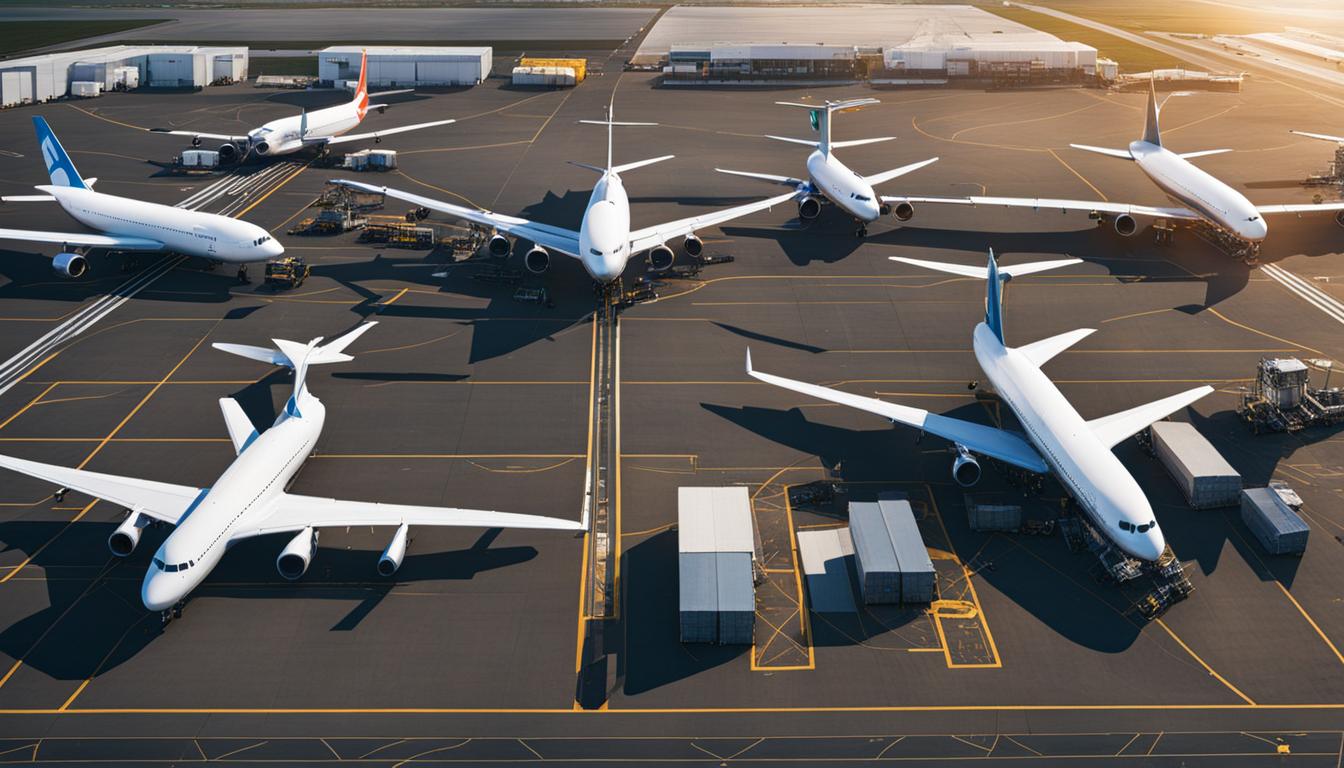The air freight industry is experiencing significant growth, with volumes reaching 65.6 million metric tons in 2021. As freight forwarders navigate global supply chain complexities and rising material costs, optimizing air cargo operations has become crucial for maintaining profitability and efficiency.
Pelicargo is at the forefront of helping forwarders optimize their costs and streamline their operations. By offering innovative strategies such as shipping on off-peak days and leveraging volume discounts through consolidation programs, Pelicargo enables forwarders to improve their cargo operation efficiency. Their platform combines advanced technology with human expertise, providing competitive rates and real-time tracking.
Key Takeaways:
- Optimizing air cargo operations is essential for enhancing efficiency and reducing costs.
- Pelicargo offers strategies like shipping on off-peak days and leveraging volume discounts through consolidation programs to optimize costs.
- Their platform combines advanced technology with human expertise for competitive rates and real-time tracking.
- Forwarders can significantly benefit from Pelicargo’s services to streamline their operations and improve their bottom line.
- Efficient air cargo operations contribute to the overall success of the industry and ensure timely deliveries.
The Challenges of Air Cargo Loading and Weight and Balance Planning
The efficient loading and weight and balance planning of air cargo are essential for optimizing cargo operations and enhancing overall performance. However, these processes present unique challenges that must be carefully addressed to streamline operations. Improving air cargo processes, streamlining cargo operations, and enhancing air cargo performance rely on effectively tackling these challenges.
One of the main challenges is creating a rational loading plan that maximizes transportation volume while ensuring aircraft balance and safety. Poor loading plans have resulted in aviation accidents in the past, emphasizing the need for careful planning and execution. Additionally, weight and balance planning play a crucial role in airplane safety, fuel consumption, cost reduction, and minimizing environmental impact.
To overcome these challenges, air cargo palletization can be utilized to improve bulk cargo transportation. By maximizing container space and enabling quick loading, cargo palletization enhances efficiency and reduces handling time. It allows for the optimal utilization of available space, resulting in increased productivity and streamlined operations.
“Proper weight and balance planning can ensure airplane safety, reduce fuel consumption and costs, and minimize environmental impact.”
By addressing the challenges of air cargo loading and weight and balance planning, businesses can optimize their operations, improve efficiency, and achieve cost savings. These improvements not only benefit individual companies but also contribute to the overall success and growth of the air cargo industry. By adopting best practices and leveraging advanced technologies, the industry can continue to evolve and meet the demands of a rapidly changing global marketplace.
| Challenge | Solution |
|---|---|
| Poor loading plans | Rational loading plans that maximize volume while maintaining balance and safety |
| Weight and balance planning | Proper planning to ensure safety, reduce fuel consumption, and minimize environmental impact |
| Efficient cargo transportation | Air cargo palletization for maximizing space and quick loading |
Optimization Models for Air Cargo Loading and Weight and Balance Planning
When it comes to optimizing air cargo operations, one of the key areas to focus on is the loading and weight and balance planning. By carefully planning the loading process and ensuring proper weight distribution, airlines can maximize payload capacity while maintaining safety and efficiency. In order to achieve this, optimization models have been developed to address these specific challenges.
These optimization models take into consideration various factors such as ULD weight and capacity, aircraft weight limits, and balance requirements. They aim to find the best possible loading plan that maximizes payload and minimizes deviation from the target center of gravity. By implementing these models, airlines can optimize their supply chain logistics, maximize air cargo productivity, and increase efficiency in cargo operations.
Implementing optimization models for air cargo loading and weight and balance planning brings several benefits. Firstly, it ensures that aircraft are loaded in the most efficient manner, making the best use of available space and reducing the need for multiple flights or wasted cargo space. This directly contributes to increased efficiency in cargo operations and cost savings for the airline.
Additionally, optimization models help to improve safety by ensuring that aircraft are balanced correctly. Proper weight and balance planning can reduce fuel consumption and costs, as well as minimize environmental impact. By finding the optimal loading plan, airlines can achieve a better balance between maximizing cargo capacity and maintaining safety standards.
Table: Comparison of Optimization Models
| Model | Features | Advantages |
|---|---|---|
| Model A | Consideration of ULD weight and capacity, aircraft weight limits, and balance requirements | Maximizes payload and minimizes deviation from center of gravity |
| Model B | Incorporates real-time data for dynamic adjustments | Allows for more accurate planning and adaptation to changing conditions |
| Model C | Integration with tracking systems | Enables real-time monitoring and adjustment of cargo loading |
These optimization models are constantly evolving and improving, offering airlines the opportunity to continuously enhance their cargo loading and weight and balance planning processes. By leveraging the power of technology and data analysis, airlines can make informed decisions that optimize their operations, improve efficiency, and ultimately drive success in the air cargo industry.
Best Practices for Optimizing Air Cargo Operations
When it comes to optimizing air cargo operations, efficiency is key. By implementing best practices, businesses can improve their processes, streamline operations, and ultimately enhance cargo operation efficiency. Here are some recommended practices to consider:
1. Image Compression and Optimization
Images play a vital role in showcasing products, providing visual information, and enhancing the overall user experience. However, large image file sizes can negatively impact website performance and slow down page loading speed, resulting in a poor user experience.
To optimize images, it is crucial to choose the appropriate image format based on its characteristics. For example, JPEG is ideal for photographs, while PNG is suitable for images with transparent backgrounds. Additionally, resizing images to match the display dimensions helps eliminate unnecessary data, reducing file size without compromising quality. Utilizing compression techniques further reduces file size while maintaining image quality.
Adding descriptive alt text to images not only improves accessibility for visually impaired users but also contributes to search engine optimization (SEO). Alt text provides a textual description of the image content, allowing search engines to understand its context and relevance.
2. Responsive Design Testing
In today’s dynamic digital landscape, it is crucial to ensure that optimized images adapt seamlessly across various devices and screen sizes. Implementing responsive design testing helps identify any discrepancies or issues in image display on different devices. By conducting thorough testing, businesses can ensure that their optimized images provide a consistent and visually appealing experience for users regardless of the device they are using.
3. File Naming and Organization
Proper file naming and organization are essential for maintaining a structured and efficient system. When saving compressed images, it is advisable to use a new filename while retaining the original high-resolution version. This helps prevent confusion and ensures easy identification of optimized images.
Organizing image files into relevant folders or categories further improves efficiency, making it easier to locate and manage images when required. Adopting a consistent naming convention and folder structure simplifies the retrieval process and minimizes the risk of misplacing or losing important images.
By following these best practices, businesses can improve their air cargo processes, streamline operations, and enhance cargo operation efficiency. Optimized images not only contribute to a seamless user experience but also positively impact website performance and SEO. Additionally, responsive design testing ensures consistency across different devices, while effective file naming and organization enhance overall operational efficiency.
Conclusion
Optimizing air cargo operations is crucial for businesses aiming to enhance efficiency, improve processes, and streamline operations. By implementing strategies such as cost optimization, cargo loading and weight balance planning optimization, and following best practices for image file size optimization, companies can optimize their supply chain logistics and increase efficiency in cargo operations.
Efficient supply chain logistics are the backbone of successful cargo operations. By continuously optimizing processes, businesses can minimize costs, improve delivery times, and maximize customer satisfaction. Strategies like shipping on off-peak days and leveraging volume discounts through consolidation programs can help forwarders optimize costs and improve their bottom line.
Air cargo loading and weight balance planning play a significant role in ensuring the safety and efficiency of operations. Utilizing proper cargo loading plans and weight and balance optimization models can maximize transportation volume while maintaining aircraft balance and safety. These models consider various constraints and provide solutions that improve upon earlier methods.
Furthermore, following best practices for image file size optimization is essential for delivering a seamless user experience across devices and screen sizes. Choosing the appropriate image format, resizing images to match display dimensions, and utilizing compression techniques can reduce file size without compromising quality. Adding descriptive alt text to images not only enhances accessibility but also improves search engine optimization.
- Understanding Bitcoin: Your Ultimate Guide to Bitcoin and Altcoins - October 15, 2024
- Introduction to Cryptocurrencies - October 14, 2024
- Bitcoin Mining and Blockchain - October 12, 2024






